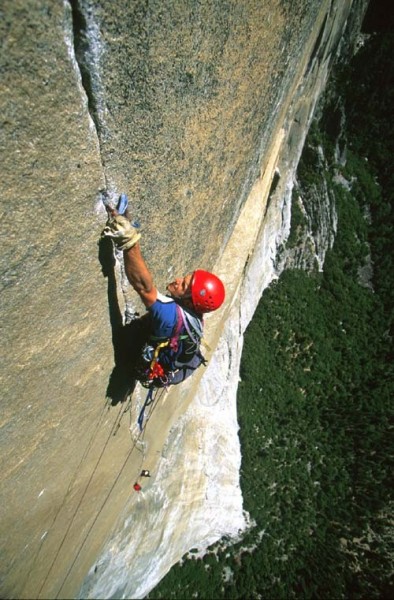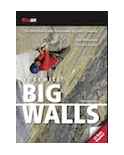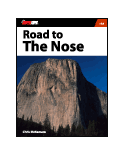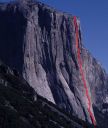This is part of the How to Big Wall Climb SuperTopo book. The videos like the ones above illustrate key points of the book and are meant to be watched while reading the book. Buy the book here or just read this free sample of the text below with photos.
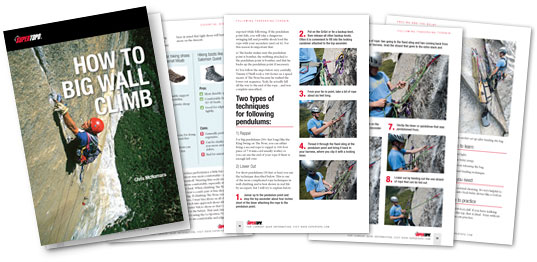
Visit on supertopo.com
A Note About Links
If you are thinking about buying some of the gear mentioned in this article, we would appreciate it if you would click on one of the links before you buy. It won’t cost you anything extra, and it does help support this website. Thanks for keeping us in mind. Our affiliates are Altrec, EMS, Moosejaw, Mountain Gear, Mammoth Gear, Backcountry, Patagonia, and REI.
Click here to see what is currently on my El Capitan rack.
Introduction
I wrote this book because big wall climbing has been the most rewarding thing in my life and I want to see more people succeed at it. The first time you climb El Cap can be the hardest and scariest. It is also the most adventurous, exciting and memorable. Fifteen years later I still clearly remember my first trip up The Captain. It is still the single most memorable day of my life. I would give anything to relieve that experience again with the same level of heightened anticipation and adventure. But you only get one “first time.” So the next best thing for me is help other people succeed and and hear their stories. I love meeting people who dream of climbing El Cap and exude that energy of half fear and half eager anticipation. You hear it in their voices. They know big wall climbing will step up their mental and physical climbing game—and they are excited about it. I hope this book becomes a starting point for an incredible adventure. And don’t forget to email me your stories or post them on SuperTopo.com so we can all live through them.
What Is a Big Wall?
A big wall is a steep, multi-pitch ascent that takes most people more than a day to climb. Big walls are all about vertical exposure—climbing and sleeping with thousands of feet of air below you and thousands of feet of rock above you. There is nothing else like it. Big wall climbing is not about summit glory or pulling a single hard move or savoring the rush of adrenaline, although all three of those things will happen. The experience is much more complex and rich. You don’t flirt with gravity like you might while BASE jumping or doing a hard single-pitch climb. You live with gravity and exposure 24 hours a day.
Plus there are side benefits, plenty of them. All big wall climbs are in stunning mountain settings. Usually you share the experience with a good friend. There is lots of time to contemplate, even read, and generally experience the slow life.
On a more philosophical level, a wall like El Capitan is just so much bigger than we are. It is mysterious, massive, and unforgiving. While nothing is truly static, the surface of El cap is about as unmoving as anything can be. Because it changes to so little… it’s a mirror. Every fear, doubt, or joy comes right back at you. People who climb big walls realize that the fact that climbing them is so hard is the reason to do it. They make you dig deep both physically and mentally.
But Isn't Aid Climbing Not That Much Fun?
I have always loved aid climbing. But I am a little weird. Among most climbers who have never climbed a big wall, aid climbing seems like cheating or just not fun. I’ve heard, “Aid climbing is like hitting your head with a hammer. It only feels good when you stop.” For most people, aid climbing is a means to an end. Few people aid climb just for aid climbing’s sake. You don't go “aid cragging” or “aid bouldering” like you would go free climbing. You aid climb to get up big walls. Aid climbing is the tool for ascending the most wild, massive, and inspiring faces in the world. And once you are up there, aid climbing through the wildly overhanging last pitch of The Nose, you won't be judging how stylish it is to aid climb. You will be too busy relishing one of the coolest locations and experiences of your life.
Sixty Percent of Nose Climbers Bail
From El Cap Meadow, photographer Tom “Ansel” Evans of the El Cap Report has probably watched more El Capitan ascents and failures than anyone. He estimates that about 60 percent of the climbers who start up The Nose bail. Why? “Most climbers think The Nose is Washington Column but bigger. It's not. El Capitan is way bigger than most people think,“ says Evans. “They jump on The Nose of El Capitan without practice so when the first glitch arises—and one does on every wall—they just bail.” On a one-pitch climb or even on a 10-pitch climb like Washington Column, you can make basic mistakes and still get your way up the wall. When you jump on a 30-pitch route, those little mistakes and inefficiencies compound and you have to bail. Anyone can climb The Nose, but they need to master the aid climbing basics and train hard.
Two Key Points
Like anything worthwhile, big wall climbing requires hard work. However, unlike climbing 5.13 or bouldering V8, big wall climbing doesn’t take heroic strength. It just requires solid 5.9-5.10 multi-pitch skills and making thousands of easy moves efficiently. That is where this book comes in. It is the first How To Big Wall book specifically organized and clearly designed to address the process of building big wall skills, step by step.
I’ve climbed more than 100 big walls and have spent more than 400 days on El Capitan. During my time I’ve seen lots of people bail, myself included. In nearly all cases they missed the two main principles of this book:
• Keep it simple.
• Master the aid climbing basics.
I believe in reducing everything to the essentials, so that’s all I put here. I include the techniques that I have found helpful and omit the rest. I'll deal with a lot of climbing myths and reject them. For example, here's my advice on four points:
• Don’t duct tape water bottles.
• Don’t use four Aiders (two work best).
• Don’t use oval carabiners.
• Don’t bother with 3 to 1 hauling systems.
My technique for hauling up huge loads of gear is this: don’t bring huge loads. Instead, climb light and efficiently so you don’t have to bring big loads. I keep the vertical baggage handling to a minimum. I spend time climbing lightly and quickly over the rock and spend minimum time moving luggage around. If every moment an aspiring wall climber spent figuring how to set up a 3 to 1 system was instead spent mastering moving in Aiders efficiently and learning to set up a simple belay, they would not need a 3 to 1 in the first place. And a lot more people would summit El Cap and enjoy the experience of getting there.
Wall Climbing Is Easy… Sorta
Technically speaking, big wall climbing is easy. Walking up a pair of Aiders is not physically or technically demanding. Jumaring is pretty straightforward once you get the hang of it. Hauling is not that complex. Each component of big wall climbing is surprisingly easy. The challenge comes in two parts:
1. Big walls require putting together a lot of unfamiliar skills and logistics.
2. These skills must be put together extremely efficiently and everything must stay organized.
These two challenges can be overcome by one simple principle: master the aid climbing basics. That is what this book is all about, a step-by-step guide to mastering the basics. You do that and all the other little aid climbing tricks will fall effortlessly into place.
Don’t Be a Vertical Baggage Handler
Personally, I don’t want just to get to the top of El Cap. I want to enjoy the climb and wall experience, spending as little time as possible dealing with haul bags and gear clusters. Maybe one day there will be a portable hot air balloon for wall climbers. All the gear, water, beer, and fish tacos you need will float just a few feet away from you and effortlessly follow you up the wall. Until that day, however, we must confront a brutal fact: we need a lot of water to stay alive and water is heavy. Conservatively, we need a gallon per person per day when wall climbing and a gallon of water weighs eight pounds. So on a five-day climb of El Cap:
8 lbs. x 2 people x 5 days = 80 lbs.
Add another two pounds per person per day for food, 20 pounds in bivvy supplies and your haul bag might tip 110 pounds at liftoff. Can you say Sufferfest?
Beyond Suffering
Even beyond the suffering issue of moving bags up a wall, there are other reasons to climb efficiently.
• Climbing efficiently keeps you safe from bad weather. You will be better able to “turn on the gas” and summit before an oncoming storm or at least make it to a more sheltered bivy spot. Most climbers who die on El Cap do so because they get caught in storms, often just a few pitches from the top. Weather forecasts won’t protect you because most weather forecasts in mountain areas are only good for a few days. Read John Dills “Staying Alive” (PDF)
• Climbing efficiently is more fun. You get to sleep on the ledge you want to, not the one forced on you by circumstance and vanishing sunlight. Or worse, having to spend the night standing in Aiders.
• Climbing efficiently is taking the right amount of water and food—not way too much or way too little.
Sneak Peak: Examples of Efficient Climbing Covered in the Book:
• Use two Aiders instead of four.
• Aid climb like you free climb.
• Spend your time at belays keeping things organized and “visualizing” what what to do once the leader is ready to haul.
• When leading, always move to the top step or second step.
• Clean with two slings that can be handed to the leader instead of handing each piece over one by one.
Efficient Climbing, Not Speed Climbing
Climbing The Nose in two bivvies instead of four does not mean becoming a frantic speed climber. You don’t have to rush every move, frantically scream at your partner to jumar faster, and take more chances when you’re leading. You just need to streamline your systems and have the aid basics dialed. If you read and practice the techniques in this book, you will cut out the hours lost to inefficiency that the typical big wall team endures and wonder why you ever climbed walls any other way.
Two Climbing Scenarios on The Nose
Just to drive home this critical point, let’s look at climbing The Nose route on El Cap under two different scenarios.
=First the Sufferfest Way, the surprisingly common way that it’s done:=
Prep Day. Climb slowly to The Sickle with a few parties nipping on your heels, trying to pass you. Spend all afternoon and into the night hauling heavy haul bags.
Day 1. Get bogged down in the Stovelegs due to heavy loads. You’re so tired from the hauling that you aid climb cracks that you had been dreaming about free climbing. Bummer. Make it to Dolt Tower after dark with little time to dial in a nice bivvy, let alone kick back and appreciate the amazing ledge and location.
Day 2. Wake up exhausted with worked hands from all the hauling. So far the climb hasn’t been much fun. You and your partner each hope the other comes up with a good excuse to bail as 60 percent of climbers usually have done by now. Climb all day and barely make it to Camp 4 by nightfall—an uncomfortable bivvy site.
Day 3. The Great Roof takes forever and antsy parties stack up behind you. You wanted to free the Pancake Flake (awesome 5.10a), but when you make a hand jam your arm cramped up so you had to aid it. Now you have to let the party behind you pass and you deal with some gnarly belay clusters in the process. The passing team offers to fix a rope and you accept. You had wanted to climb every pitch but you are moving slowly and don’t want to climb into the night again. You make it to a crowded Camp 5 and have to take the lame bivvy sites and hope the team above you doesn’t pee on you.
Day 4. At this point the haul bag is getting lighter but all the heavy hauling down low has wrecked your hands and drained your strength. You have to aid everything, even the easy free climbing, which makes you move even slower. The turd bucket is getting dangerously close to overflowing. You have to bivvy on Camp 6 and another party catches up to you, creating another cluster.
Day 5. You have to ration your food and water, which just ads to your malaise. You finally top out. You are relieved and feel proud to have summited. However, because of the hauling, bad bivies, and belay clusters, climbing what is probably the best route in the world was not much fun.
=Now, the Efficient (non-Sufferfest) way to climb El Cap:=
Prep Day/ Start early and zip up the first four pitches in a half day. Return to the ground and have plenty of time to haul to Sickle or just do “the El Cap Lieback” in El Cap Meadow.
Day 1. Blast off and pass a party in the Stovelegs by climbing variations around them. With a light haul bag holding only three days of food and water, the hauling is easy and you have plenty of strength to free climb these classic pitches. Get to El Cap Tower with plenty of time to kick back and enjoy the view.
Day 2. Cruise through the King Swing and the Great Roof. With a light bag, easy hauling means you still have enough strength to free climb Pancake Flake. Oh, it's so good! And exposed! You have enough time to choose Camp 5 or Camp 6 (whichever has fewer people). At this point the bag weighs almost nothing.
Day 3. Pass that suffering party I described above. You give them a little water because even though they started with 80 pounds of water, they are almost out. Three pitches from the top you feel a potential afternoon thunderstorm developing. You step on the gas and blast through the final pitches, topping out before the rain starts. There is plenty of time to pack up, walk down, and still buy a 6-pack before the store closes.
Three Paths
So there you have it, there are essentially three paths:
The Basic Equation of Efficient Climbing
A little time saved on an action, when multiplied by thousands of actions on a wall = giant time savings.
For example, on The Nose:
Leading a pitch 10 minutes faster multiplied by 31 pitches = 5+ hours.
Saving 5 minutes on a belay change-over multiplied by 31 pitches = 2.5+ hours.
Save 3 minutes while lowering out the bag and leaving the belay multiplied by 31 pitches = 1.5 hours
You haven’t done any fancy “speed climbing” and you have already shaved a day off the climb.
Now, imagine, after dialing the skills in this book you shave 20 minutes off leading each pitch. Belay changeovers that used to take 12 minutes take 2.
There are other things that can’t be quantified in time: hauling with less effort over 31 pitches = more energy for free climbing the classic pitches and more fun.
How to Use This Book—The Road to The Nose Master Checklist
This book is intended to be “active reading.” Print or photocopy the Master Checklist and take it with you on all your training. Every time you get to a major stage, celebrate!
Open up the first chapter on Aid Basics and go out and practice, practice, practice. Make sure you check off everything on the Master Checklist. Then you’ll move onto Chapter 2 and get that dialed and so on. If you have never aid climbed, you are lucky. You don’t have bad habits yet. If you don’t skip ahead, and instead master each section, one chapter at a time, you are on the path to cruising up El Cap.
Okay, maybe skim through the entire book once. That’s allowed. But I encourage you to read this book slowly, dialing in each section before skipping ahead. Don’t skip around to pick things here and there.
Some folks out there may say, “But I already know the basics, I want to know how to stack pitons or set up a complex hauling system.” While I can’t call BS without actually seeing you aid climb, the vast majority of aid climbers I see on El Cap could still use a lot of help with the aid basics. So even if you are moderately experienced at aid climbing, please don’t skip ahead.
About the Gear in This Book
This book has many gear photos. I am not sponsored. At the time of publication, this is the gear I like to use. While I like the products you see in the book, other gear might work better for you. The only way to know is to experiment for yourself. Here is my current El Capitan rack. In addition, we have written a number of reviews on popular big wall gear
Winding Up
By the way, this is the only section of the book where I am quite so long- winded. After this rant, where I try to convince you to do things as simply as possible, I’ll heed my own advice and write as simply as possible. I’m working at it—the first draft of this book was three times as long but I pared it down to just the essentials.
PS: I want to hear success stories! If this book helped you get to the summit of EL Cap, please email me: chris@supertopo.com. I would love to hear about it.
